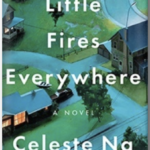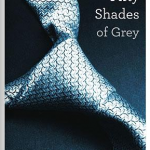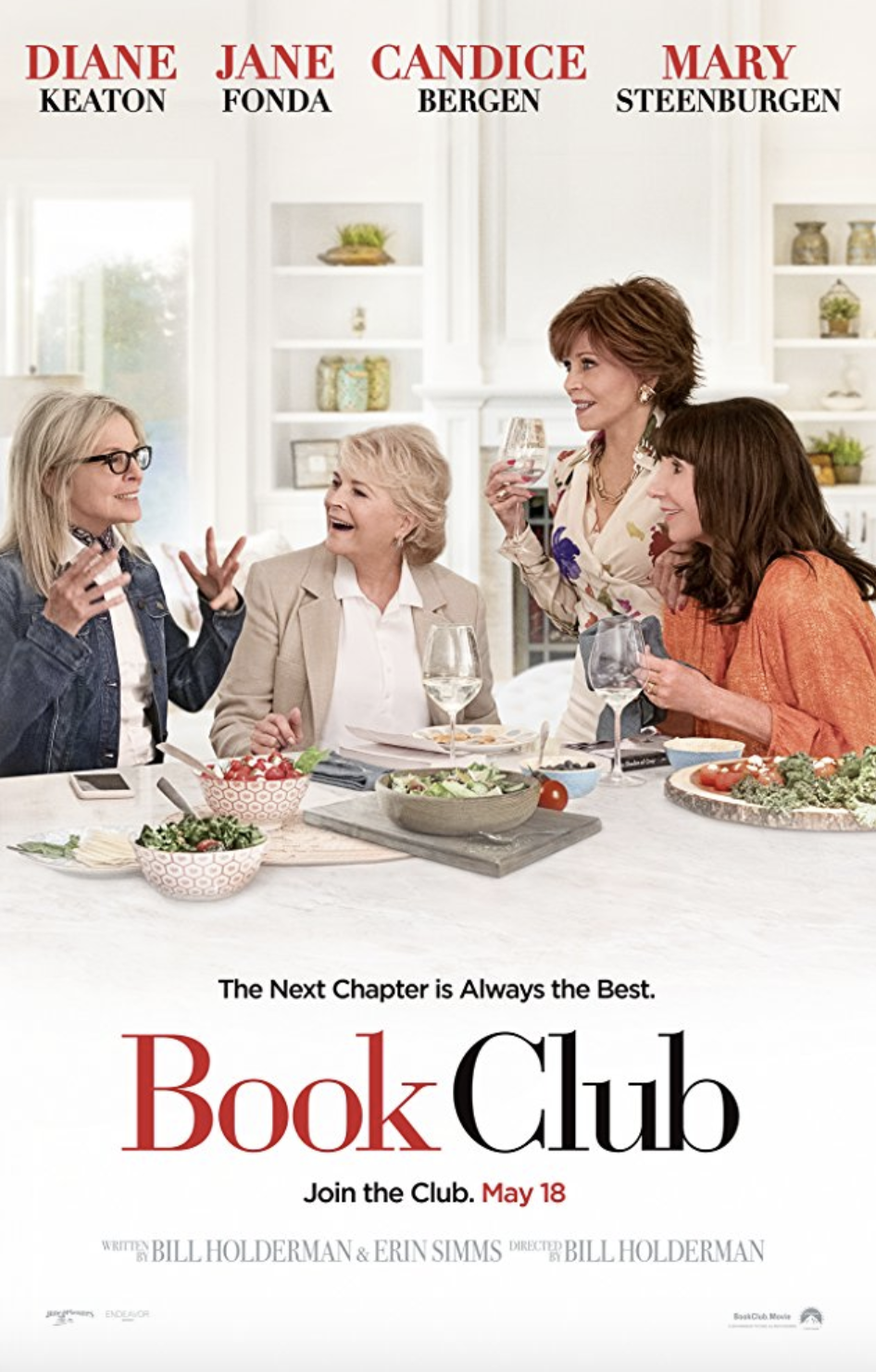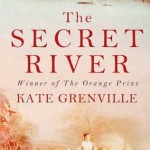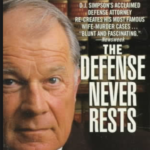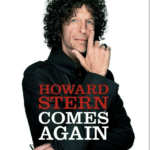Search results for ‘Once We Were Brothers’
Once We Were Brothers by Ronald H. Balson
August 14th, 2014 — 05:28 pm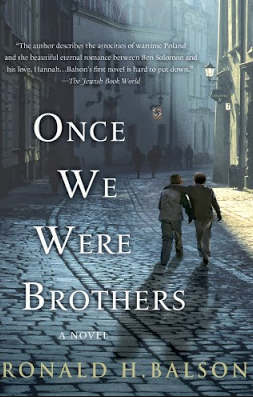 Once We Were Brothers. – By Ronald H. Balson- I am always interested in another Holocaust novel. Perhaps I don’t want to forget (how could one forget?). Or perhaps it is the trying to figure out how would I have handled these horrible situations had I been born a few generations earlier where some of my ancestors had lived and died. It helps that the author in this case; Ronald Balson has a fresh perspective. He introduces us to situation where Ben Solomon, an elderly Holocaust survivor confronts Elliot Rosenzweig, a very wealthy Chicago philanthropist, of actually being Otto Piatek, a prominent Nazi who executed many Jews in Poland during WW II. On top of this he tells a story how Otto as a young boy had been taken into his household before the war after his own parents abandoned him. When the Nazi’s came to power his parents returned to take the 18 year old back to Germany where he became a high-ranking Nazi who was soon to be assigned to Poland. The now wealthy Chicago man denies this accusation and the plot unfolds as Ben relates his story to Catherine who he hopes will be his attorney in what he wants to be a public lawsuit to expose this man for stealing his and other family’s money and jewels as well as participating in the murder of so many Jews. Ben painfully reveals his memory of the events of his childhood growing up with this man and the hope that Ben’s parents had that the child they had taken in would help them from his new position. Using this vehicle, the horrific details of the plight of the Jews in Poland are related. So many historical details were worked into the story that I had the impression that this first time author had on his writing desk a history book of all the events that happened in Poland at that time There were twists and turns but there were all familiar situations: the gradual tightening of the noose around the neck of the Jews as they were moved into the Ghetto and eventually were taken to concentrations camps. There was the good Priest hiding some Jews and the underground resistance doing it’s thing and of course the horrendous course of events for so many Jews. It was also a personal story of certain people who we came to know and care about as events transpired during the war and now in modern times as the possibility of a legal trial became a reality.
Once We Were Brothers. – By Ronald H. Balson- I am always interested in another Holocaust novel. Perhaps I don’t want to forget (how could one forget?). Or perhaps it is the trying to figure out how would I have handled these horrible situations had I been born a few generations earlier where some of my ancestors had lived and died. It helps that the author in this case; Ronald Balson has a fresh perspective. He introduces us to situation where Ben Solomon, an elderly Holocaust survivor confronts Elliot Rosenzweig, a very wealthy Chicago philanthropist, of actually being Otto Piatek, a prominent Nazi who executed many Jews in Poland during WW II. On top of this he tells a story how Otto as a young boy had been taken into his household before the war after his own parents abandoned him. When the Nazi’s came to power his parents returned to take the 18 year old back to Germany where he became a high-ranking Nazi who was soon to be assigned to Poland. The now wealthy Chicago man denies this accusation and the plot unfolds as Ben relates his story to Catherine who he hopes will be his attorney in what he wants to be a public lawsuit to expose this man for stealing his and other family’s money and jewels as well as participating in the murder of so many Jews. Ben painfully reveals his memory of the events of his childhood growing up with this man and the hope that Ben’s parents had that the child they had taken in would help them from his new position. Using this vehicle, the horrific details of the plight of the Jews in Poland are related. So many historical details were worked into the story that I had the impression that this first time author had on his writing desk a history book of all the events that happened in Poland at that time There were twists and turns but there were all familiar situations: the gradual tightening of the noose around the neck of the Jews as they were moved into the Ghetto and eventually were taken to concentrations camps. There was the good Priest hiding some Jews and the underground resistance doing it’s thing and of course the horrendous course of events for so many Jews. It was also a personal story of certain people who we came to know and care about as events transpired during the war and now in modern times as the possibility of a legal trial became a reality.
Although I have experienced many other books and movies about the Holocaust, I was still engrossed and moved by this book. It was not one of the best of the lot on this subject but if you are drawn to this subject you will not be disappointed.
The Wright Brothers by David McCullough
January 21st, 2016 — 10:26 pm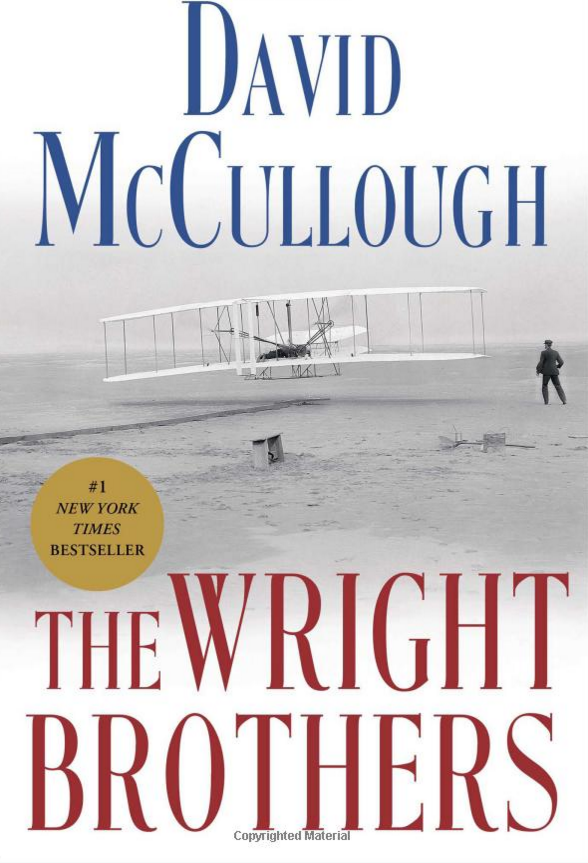 The Wright Brothers by David McCullough
The Wright Brothers by David McCullough
We all know that two wrongs don’t make a right. So when I showed my 9-year-old granddaughter this book that I was reading and asked her if she knew what it was about, she gave me the riddle, “What do two rights make?” An airplane of course.
David McCullough, two-time Pulitzer Prize winning author for Truman and John Adams has taken on two additional American heroes, Wilbur and Orville Wright. McCullough had a trove of documents to work on, mostly now residing in the Library of Congress and in museums in the Wright Brothers hometown of Dayton, Ohio. Obviously there were no instant messages, iPhones, or e-mail correspondence during their lifetimes and like many of their contemporaries, they wrote numerous letters and kept extensive diaries. McCullough mined these sources as well as the newspapers and magazines of that era.
Wilbur was four years older than Orville. They had two older brothers and a younger sister and there were two twins born in between Orville and Wilbur who died at birth. Their father was a Bishop in the Church of the United Brethren of Christ who traveled a great deal. Their mother, who it was said to had given them their mechanical ability, died three years before their first flight at Kitty Hawk in 1902. The family was very close and supported each other. Katharine, the sister, who was a teacher shared very much in the Wright Brothers’ success and traveled with them at the time that they received worldwide acclaim.
Perhaps it is a screen memory (an unconscious one constructed in retrospect) but the brothers recalled their father bringing home a toy for them when they were quite young which was a helicopter which flew with twisted rubber bands and suggested that this possibly was the origin of their interest in flying. A first-grade teacher remembers Orville sitting at his desk with bits of wood and telling her he was making a machine of a kind that he and his brother would fly someday.
Wilbur and Orville were obviously extremely bright although they never went to college. They opened a print shop while in high school and went on to open a bicycle store where they made and sold bicycles. This was the environment in which they began working on a flying machine.
McCullough traces with the accuracy of the historian that he is, each step of the Wright Brothers journey. Initially building a glider and then the development of intricate wings that could do special movement that the brothers meticulously developed. He describes the addition of the motor and propeller. We learned about the people throughout the world who were trying to be the first in flight and their relationship with the Wright Brothers. This book focuses mainly on an approximate a 10-year period from Kitty Hawk to the glorious flights in Paris and New York.
Overall, there seemed to be great camaraderie between the various pioneers of flight throughout the world with the Wright Brothers. However, there were some conflicts and some patent disputes that the Wright Brothers had with other flyers of the day. Ultimately, there was tremendous acclaim for the Wright Brothers. I think it is worth quoting the words of President Taft upon presenting the Wright Brothers with some awards in the White House. He said:
I esteem it a great honor and an opportunity to present these medals to you as an evidence of what you have done.I am so glad perhaps at a delayed hour to show that in America it is not true that “a prophet is not without honor save in his own country.” It is especially gratifying thus to note a great step in human discovery by paying honor to men who bear it so modestly. You made this discovery by a course that we of America like to feel is distinctly American – by keeping your noses right at the job until you have accomplished which you had determined to do.
According to McCullough there was rarely friction between the Wright Brothers themselves. They were a well oiled team who understood each others’ strengths and worked very smoothly together. While their relationship was detailed very clearly, what seemed to be missing was their personal lives. Either the author chose not to include any special social interactions or there essentially were none. It is hard to believe that there is no mention of any girlfriends or romantic interests. When Wilbur died in 1912 at the age of 45, Orville and his sister Katherine moved into a new house with their father. Orville became involved in their business details which now were quite complicated as the famed inventor. When at the age of 59 his sister decided to get married, Orville was reported to be very disturbed and negative about her plan which she carried out anyway.
I, probably like most of you, take flying for granted. I am more concerned about the arrival time, legroom, and how I should occupy myself during the flight. David McCullough’s book provides an unforgettable tribute to the brothers from Dayton, Ohio who made all of our flights possible.
Comment » | B - Biography, HI - History, T - Recommended for Teenagers, Uncategorized
All The Light We Cannot See by Anthony Doerr
February 25th, 2015 — 02:40 pm‘All the Light We Cannot See’ by Anthony Doerr. 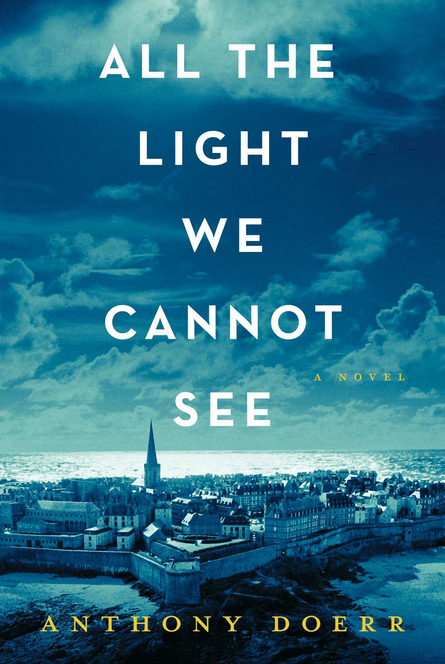
Why does a man who was born more than 30 years after the start of World War II decide to write about the lives of a young blind girl and a German youth during this period of time where their lives ultimately intersect?And why do I, who was born just before the start of this war, find myself still seeking out books about this period of time? This is a question I cannot answer, but I do have a recommendation for the readers of this blog, which I will share at the conclusion of this review.
Marie-Laure was born in Paris and became blind at the age of six. She was the daughter of a widowed locksmith of the Natural Museum of Paris. She was very close to her father, who when war broke out fled with her to the seaside town of Saint-Malo. They lived with her great-uncle who had been traumatized by World War I and was afraid to go out in the street. She was left living with him when her father did not return from a trip to Paris.The great-uncle had a radio in his attic, to which they could listen, as well as transmit. Werner Pfennig was a German orphan who grew up in a children’s home in Berlin. He developed a fascination with and the knowledge about radio circuits, which was the skill that ultimately became his work in the Nazi Army. There are many sub-themes in this developing story, which include the tale of a valuable blue diamond, which people believed gave special powers to those who possessed it. There also was a description of the ruthless training of the German youths and of the bravery of some of the French citizens that occurred during wartime.
Each chapter ultimately alternated between the lives of the blind French girl and the young German lad, as well as a few other people. It should not be surprising to learn that this book is very well-written and well-received. It received a National Book Award and was on the ‘New York Times’ bestseller list for 38 weeks. By examining the microcosm of these two persons’ lives the reader gets a feeling of the humanity, or the lack of it, of some of the people who lived and died during this horrendous recent history. As well-written as this book may be, it is really still a figment of the imagination of the talented Mr. Doerr. It is a fine piece of literature that could round out a reading list for the contemporary reader. However, if you are a young person wishing to be educated on this dark period of 20th Century history or even an older person who has not previously explored this era, this book may not be the place to start. I would suggest two other books; one a classic and the other one probably read by very few people. If you have not read it, I suggest that you read ‘The Diary of a Young Girl’ by Anne Frank, which is the memoir of a young girl in Holland during the Nazi occupation. This perhaps is the most well-known and well-received book about this period of time. The other book that I would suggest is ‘How We Survived – 52 Personal Stories by Child Survivors of the Holocaust’ (See my review of this book). This is a vivid, valid and authentic group of short vignettes that will hold your attention and tell a story as informative and moving as the fine novel which I just reviewed.There are also some other recent novels about the Holocaust that I would bring to your attention: ‘Once We Were Brothers’ by Ronald Balson, ‘My Sister’s Keeper’ by Jodi Picoult and ‘The Book Thief’ by Markus Zusak.( see my reviews of these books) This is obviously a topic that can be explored with many fine pieces of literature, and this book by Mr. Doerr is a very good addition to this library of books.
From sand and Ash by Amy Harmon
January 6th, 2018 — 12:37 am From Sand and Ash by Amy Harmon
From Sand and Ash by Amy Harmon
If I had to make a list of the books that made the greatest impression upon me, I’m pretty sure I would include the Diary of Anne Frank, Schindler’s List and Sophie’s Choice. Not surprising these books all deal with the Holocaust. Growing up in the post World War II, I became acutely aware of the details of what was done to the Jewish people in Europe in the previous decade. My own relatives who are not “survivors” but had family in Europe who perished during that period of time rarely talked about the details which probably fueled my interest. Being Jewish, I felt a personal connection to understand this horrific period of history. As a young psychiatrist working in Brooklyn, I treated a number of children of concentration camp survivors which made a lasting impression on me.
In the past few years, several excellent books which delved into this subject have been reviewed in this blog. This includes How we Survived, The Nightingale, All the Light We Cannot See, Once We Were Brothers, Maus I&II and The Book Thief.(you can click these titles to see my review of each of them )
This current novel From Sand and Ash by Amy Harmon examines the impact of the Holocaust in Italy. In particular, it puts a light on the heroic efforts of members of the Catholic clergy who secretly risked their lives to save many Jews who had become the target of the fascist government of Mussolini which was was allied with Hitler.
The main characters are a Catholic priest and a Jewish young woman who grew up together since childhood. The author in the postscript revealed that these characters were fictional but all the horrible events depicted were real and based on factual events. The author appeared to pay close attention to historical details at the same time that she wrote a beautiful love story. As I finally closed the book after completing it I asked myself three familiar questions: How could so many people do such terrible things to the Jews? How did some people develop the courage to risk their lives and the lives of their families to try to hide and save so many Jews. What would I have done if I had faced the challenges of that time period?
This is a well-written book that may not answer these questions but will provide a page turning experience, which will hold your interest and attention as well as connecting to your emotions.
To purchase this book from Amazon, please click here
Comment » | FH - Fiction Historical, FR - Fiction Romance, Uncategorized
Dark Money by Jane Meyer
May 7th, 2016 — 12:16 pm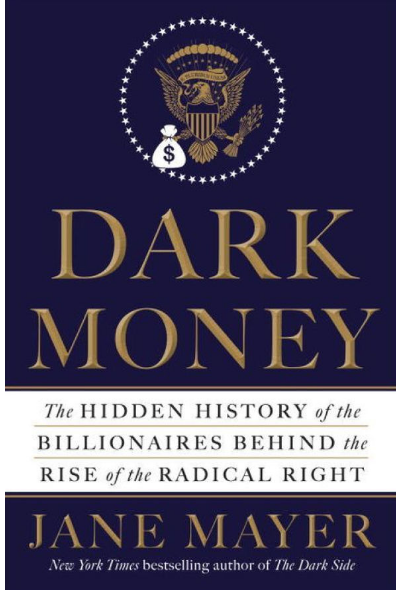 Dark Money: The Hidden History of Billionaires Behind the Rise of the Radical Right By Jane Mayer
Dark Money: The Hidden History of Billionaires Behind the Rise of the Radical Right By Jane Mayer
Jane Mayer is an award winning investigative reporter who writes for the New Yorker Magazine.
This book is long and somewhat repetitious but it presents a clear undeniable exposition that shows how our free democratic government, founded on checks and balances is being corrupted by a small group of very wealthy individuals. Multi-millions, if not billions of dollars are being used, often secretly, often with the pretense of tax-free donations, all which are funneled to individuals and organizations with the main purpose of supporting the interest of the super wealthy people who control these funds. This is a clear evasion of existing tax laws with the goal of lowering tax rates for billionaires and multi-millionaires, who often believe they should be paying lower tax rates than the middle class. There also is a campaign to change government regulations to favor their business holdings.
The undisputed leaders of this calculated, spending of “dark money” are brothers, David and Charles Koch, two of the richest men in the world who continue to expand their wealth through their massive holdings in fossil fuel and chemical industries. They lead a group of extremely wealthy men including Richard Mellon Scaife, heir to the Mellon Banking and gulf oil fortune, the Coors family who founded Amway, John Owen and his family also from the chemical industry and many others. It is not surprising that this group also denies and disputes the established scientific reality of climate change and the threatened dangers to our planet. This well-documented book, with extensive references and bibliography exposes the nefarious actions and manipulations of the relatively small group of very rich people who have a radical conservative agenda.
The Citizens United ruling by the United States Supreme Court, allowed the Koch brothers and other ultra conservatives to make unlimited contributions to independent expenditures. This meant that these groups could support political action committees that were officially not tied to particular candidates in any way. The Citizens United, Supreme Court decision also allowed that there could be unlimited spending for candidates, as long as the candidate was not involved with how the money was spent. This ruling sent a message to the wealthy and their political operatives that when it came to raising and spending money for political candidates, they could act with impunity. Soon, hundreds of millions of dollars from Koch and his wealthy colleagues were flowing to support their favorite candidates. This opened the floodgates for all special interest groups, mainly from the ultra right, including foreign corporations, to spend money without limit in the US elections. The details, including names, secret deals, etc. are all documented throughout this book.
A further example of how this group of wealthy conservatives scammed and manipulated government elections throughout the country is how they use the federal law pertaining to the IRS tax code known as 501(c)(4). This regulation allows tax-free donations to organizations that are exempt from paying federal taxes if they are listed as a civic group or are operating exclusively for the promotion of social welfare or they are a local association of employees with limited membership. These organizations are allowed to engage in unlimited lobbying as long as it pertains to the organization’s mission. Sometimes, the organization would be set up as a charity and it would be able to receive tax-free donations. Other times, when the donations were not deductable, the donors would write them off as business expenses. Many of these organizations received the funds under the guise of having honorable, civic concerns but actually closer examination showed that many of them were non-existent as a functioning organization but were rather just a post office box run by a few individuals well-connected to the Koch brothers and their friends who would furnish huge amounts of money through these organizations in support of political candidates in state elections and in the House of Representative, who were pledged to advocate for the needs of their donors.
One of the really eye-opening subjects covered in this book is the description and documentation of how conservative donors have tried to influence and gain control of higher education in America. The seminal event, which precipitated and motivated these actions, was the famous show of “Black Power” during an uprising at Cornell University in April 1964. As some of you may recall or may have read about, 80 black students marched out of the student union with their clenched fist held high in the Black Power salute and several of them were brandishing guns. The pressure brought on university officials because of this action led to the acceleration and planning to establish undergraduate black studies programs at Cornell and then subsequently at other universities. In response to these actions and in order to counter them, one of the wealthy billionaires, John Owen set up a mechanism to begin to funnel funds to various universities throughout the country, often hiding the exact source of the money. Funds went to universities to establish think tanks, special studies departments, endowed professorships, all geared to the ultra conservative agenda. Part of their goal was to establish courses in universities that would teach conservative economic theories, lecture students about the “climate change myth”, teach theories and write books that expounded lowering taxes for the rich and reducing financial support for the poor. All of these one-sided ideas would have caused benefit for donors of these huge funds. This was a secret agenda and millions and millions of dollars were brought into universities throughout the United States. This movement, plus the pouring of money into the election process began to allow conservatives to develop an increasingly large constituency, which gained strength in the state government and also allowed the ultra right to gain seats in the House of Representatives of the US Congress. The subsequent Republican congress limited President Obama’s ability to develop his agenda and is now also expected to play a major role in the 2016 election.
This book review has just touched upon a few of the highlights or should I say low points of what is documented in Jane Mayer’s book. It is ongoing and actually is quite depressing. However, it is really very important that every American citizen should be aware of the corruption of our political system with the behind the scenes, hidden history of secret deals with dark money.
To obtain a copy of this book from Amazon, please click here
Moving On- A Life by Oliver Sacks
December 18th, 2015 — 09:48 pmMoving On – A Life by Oliver Sacks
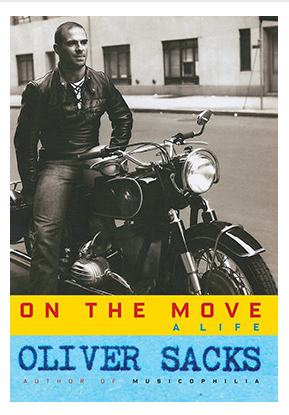 I never read any of his books other than this biography. I read about many of them. I don’t recall hearing him speak in person although I believe I attended one of his lectures at the American Psychiatric Association meeting. I was familiar with many of the places that he spoke about in New York, San Francisco and Los Angeles and I even had some friends and colleagues who knew his analyst, David Shengold. Although I was never anywhere near being in his league as a clinician, writer and brilliant mind, his areas of interest had always fascinated me. So I guess you can say in reading this book, I had a certain amount of kinship and empathy for him although in many ways he was miles apart from my world.
I never read any of his books other than this biography. I read about many of them. I don’t recall hearing him speak in person although I believe I attended one of his lectures at the American Psychiatric Association meeting. I was familiar with many of the places that he spoke about in New York, San Francisco and Los Angeles and I even had some friends and colleagues who knew his analyst, David Shengold. Although I was never anywhere near being in his league as a clinician, writer and brilliant mind, his areas of interest had always fascinated me. So I guess you can say in reading this book, I had a certain amount of kinship and empathy for him although in many ways he was miles apart from my world.
He was born in England to a Jewish family. Two of his cousins were Al Capp, the famous cartoonist and Abba Eden, a famed Israeli Prime Minister. One of his brothers was schizophrenic and we can’t help wondering if his desire to crack the code on the workings of the brain may have had its origin with that experience. Both his parents were physicians and he has early memories of hearing them discuss interesting cases. His father thought it was a shame when a case was written up in the popular press but his mother was a great storyteller. No doubt it was at his parent’s knee that he became fascinated by case histories.
The reader of this book will benefit by his ability to tell good stories. At times he jumps around and he may lose you with the exact time sequence but that will be a small price to pay for an interesting story of a brilliant man who led his life, well lived, his way.
It was his misfortune to be born gay at a time when it was considered to be a choice, rather than an inborn destiny that we know it is today. It is sad to hear that after he had his first sexual experience, he had none for the next 35 years. It was heartwarming to see that he fell in love and was able to live a happy intimate life with a man in the twilight of his life.
In a small way, I could relate to his early fascination with the working of the brain and the scientific advances that were occurring, as he was completing medical school and making the decision to become a neurologist. This was approximately the time that I was in college in the late 1950s. I had participated in a special project where we implanted electrodes into the brain of a cat, in which we could then record after the cat had recovered from surgery and resumed it’s relatively normal life. There were situations where we could tell in advance when the cat was going to make a decision, based on the brain waves before the cat made them. It was very tempting for me because of this experience to want to choose a career in neurology but for me, clinical psychiatry beckoned and that became the direction that I took. We are all fortunate that Dr. Sacks followed his interest in the workings of the brain.
When Dr. Sacks came to the United States, he was in his ‘20s and his first stop was San Francisco where he became an intern at Mount Zion Hospital. Not only was this young doctor quite fearless on his motorcycle but he was also fearless in his self-experimentation with LSD, PCP, later known as Angel Dust and who knows what else. I am sure his experience with mind altering drugs at this time paved the way to his lifelong study of the brain and the workings of the mind.
He dropped a tidbit taking place during this time period about how he got out of the draft. I know firsthand that young doctors were subject to being drafted into the military during both the Korean War and the Vietnam War. It was in 1968 that he said that he persuaded the draft board that he was not suitable material for the draft. I wonder what this was all about.
As someone who has worked in academia, I was particularly interested in what he had to say about one of his first jobs working in a clinical research lab. He reports that on his own, he made observations that he felt merited a write-up for a journal. When he wrote his first paper and it was accepted for publication, his boss was furious and fired him and then according to Dr. Sacks used some of his data which the boss claimed was his own for another publication. I have seen similar situations where there is conflict between the young person and the father figure. I can’t help wondering what would have happened if Sacks had tried to collaborate with his boss. In later years, he described getting along well with his colleagues and sharing data and theories but on the other hand, there seems to be a certain lone wolf quality and approach to his ultimate final products. I really can’t say if he was generous in allowing co-authorships with younger colleagues when he was the famous established author.
His life in Southern California was particularly fun to read about, since he had a house in Topanga Canyon, which is near the area where I now live. He reports zooming around on his motorcycle and it was obviously quite different than it is now, trying to get around on the busy freeway. He reports that he became the doctor of sorts to the Hells Angels, as well as being a Venice Beach bodybuilder.
He really seemed to come into his own once he came to New York. One might have expected him to join the full time faculty at one of the many outstanding medical schools. Instead, he decided to become the peripatetic neurologist by being a consultant to the Beth Abraham Nursing Home , the Little Sisters Nursing Home, both known as “ Manors,” among other places. It was here that he made his groundbreaking observation on post encephalitic patients who received L-DOPA and have their “Awakenings,” often temporary but revealing great insight into the workings of the brain.
His book, by the same name became a New York Times bestseller for 26 weeks and was made into a screenplay by Harold Pinter and into a great movie in which he was played by Robin Williams. This was followed by a number of other world famous books such as The Man Who Mistook His Wife For His Hat, Hallucinations and many others
In his heart and soul, it was clear that he was a storyteller. His understanding of neurology allowed him to listen and observe his patients and make insights that were not only fascinating but were important scientific advances for his time. He was also able to educate the public with his ability to write and make his case histories come alive as real people with unusual problems. He was unbelievably prolific and accumulated thousands of diaries filled with observations of his patients and of the people that he met and interacted with. He became friends and corresponded with some of the great minds of his time, such as Francis Crick (of the DNA guys Watson and Crick) and Stephen Jay Gould as well as Gerry Edelman, author of the groundbreaking book, Neural Darwinism which Sacks explains in great detail in the biography.
Although I don’t think he mentioned it his book, I read elsewhere and that some of the subjects of his writings didn’t like that they were described in a manner in which t they could be recognized. Perhaps he didn’t get what we now call “informed consent.” He obviously wrote because of his love of the subjects he wrote about as well as because of the love that he had for these people whom he got to know.
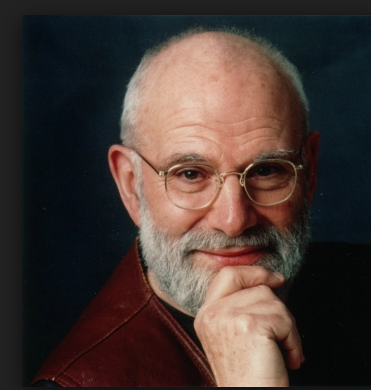 One of the most important subjects of his writings that he definitely had permission to write about was himself. When he severely injured his leg, he was able to write a book titled A Leg to Stand On. In his waning years, he developed a melanoma in his retina. This stimulated him to enlarge upon his earlier observations about vision and consciousness. No doubt , he developed a personal attachment to the people he wrote about but he seemed to be also writing for the personal gratification and acceptance of himself and his works. He related a situation where due to one of his books receiving bad reviews, he went through 3 months of being severely depressed .
One of the most important subjects of his writings that he definitely had permission to write about was himself. When he severely injured his leg, he was able to write a book titled A Leg to Stand On. In his waning years, he developed a melanoma in his retina. This stimulated him to enlarge upon his earlier observations about vision and consciousness. No doubt , he developed a personal attachment to the people he wrote about but he seemed to be also writing for the personal gratification and acceptance of himself and his works. He related a situation where due to one of his books receiving bad reviews, he went through 3 months of being severely depressed .
Oliver Sacks certainly lived his life to the fullest, He received much recognition for his work. He was also recognized by the Queen of England and honored with the designation of Commander. Not only did he receive much satisfaction from his many accomplishments, but he was able to share so much of his thought process and insights with the people who read his papers and books. He passed away a few months ago (August 2015) but I’m sure that his stories and observations will live on for many generations.
The Invention of Wings by Sue Monk Kidd
August 19th, 2014 — 11:52 amThe Invention of Wings by Sue Monk Kidd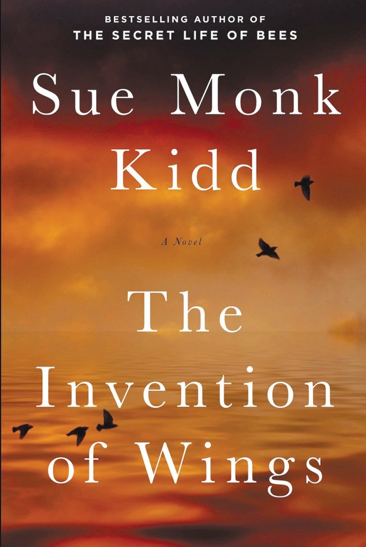
It is less than 200 years ago that slavery was a fixture in this country. As part of the curriculum in American schools we learn about this horrific treatment of human beings in the South and how the North tolerated this institution until the Emancipation Proclamation and ultimately the Civil War. However, I wonder if each succeeding generation of Americans really understands and appreciates what it was like to be enslaved in America and how this was accepted as part of everyday life by so many of the white people? When the award winning movie Twelve Years a Slave was released, there were some people who were disturbed by it because they felt it was too “painful to watch.” We are fortunate that there are filmmakers and in this case an author who can find a creative approach, to not only tell the story of slavery in the United States, but to do it a way that we not only understand what went on but that we can also have some idea of how the victims of slavery felt. I will say that this empathic experience for the most part extends to the oppressed rather than to understand the mindset of so many people who accepted this institution without question.
In this book we mostly follow two women for most of their lives. One is Sarah Grimke, born into a wealthy Charleston family at the beginning of the 19th century. Her father was a prominent judge, her mother was a socialite, her brothers were destined to be prominent lawyers and she and her sisters were expected to follow in her mother’s footsteps. Slavery was a way of life and there were 15- or so “Negroes” living in their house, each of whom had various duties. When there were children of the slaves, they would be brought up to follow in their parent’s footsteps. In fact, one such young girl was Hetty Handful who was presented to Sarah as a present for her 11th birthday to be her personal “slave.” Sarah rejects this plan, as much as a girl her age can reject the rules and the plan of the family. She secretly begins to teach Hetty to read which is forbidden. We meet Sarah’s father, the patriarch of the family and we see his acceptance of slavery with barely a reservation as well as his clear ideas about the limited role of women. We meet Charlotte, Hetty’s mom and a most skillful seamstress but a woman who knows where she came from and what she will never accept.
The reader becomes a fly on the wall in this household for the next several years as these girls grow up. We come to know the other members of this household, both slave and non-slave. We learn about the courting tradition, as Sarah and her sisters are formally allowed meet men at the proper time. The reader is introduced to how the slaves are punished when they make mistakes which can be a whipping or even worse (and the latter is described in vivid detail). Sarah develops a very close relationship with one of her younger sisters Nina, as at her own requests she is granted the role of godmother to her. Not surprising, their social values are quite similar and we are able to follow their fascinating paths, as both become prominent abolitionists. As in any good novel there are various sub stories. While the chapters alternate between “ Sarah “ and “ Hetty,” the fate of Charlotte, Hetty’s mother and Nina, Sarah’s special sister, inform the latter part of the book. As the story progresses, it also becomes clear that this not only a story about slavery in the United States but it is also about the beginning of the fight of woman to achieve equality in this country.
In fact, I don’t believe that it will spoil your enjoyment of this compelling novel, if I reveal what the author has put in a note at the conclusion of the book. That is that Sarah Grimke and her sister Nina Grimke were real people. They both became prominent abolitionists as well as advocates for women’s rights despite some concerns by supporters who believed that such rallying might dilute the difficult fight against slavery. While the dialogue, many subplots and storylines were the author’s imagination, other events and even some quotes were taken from some writings, biographies and historical reports which therefore confirms the feel of this story, which is one of authenticity. It is a book that captivates and holds you until the last line!
My Happy Days in Hollywood: A Memoir by Garry Marshall
June 14th, 2012 — 10:32 pmMy Happy Days in Hollywood : A Memoir by Garry Marshall ( 2012)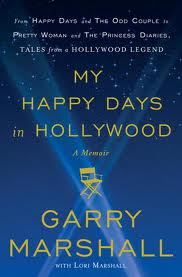
You will definitely like this book if you have been a fan of Garry Marshall and appreciate all the work that he has done in movies and television. If you read his earlier book, Wake Me When It’s Funny: How to Break Into Show Business and Stay There (1997) you will find this current book a partial restatement of his accomplishments plus his newest work, as well as his more philosophical look at life, now that he is on the other side of 75. His orientation and values towards show business originates at the knee of his mother who ran a local dancing school and had once been a dancer herself. As a youngster he had the ability to make people laugh and his parents appreciate and encouraged this talent. He was born in the Bronx and attended DeWitt High School. He then went to Northwestern University, which is known for it’s journalism studies where Marshall proved to be talented sports writer. After graduation he found out that he could make a living writing jokes for comedians. He started supplying funny lines for Phil Foster and Joey Bishop. This led him to become a writer for The Tonight Show which in the late 50’s and early 60’s starred Jack Paar. He branched out to writing for The Lucy Show and Lucille Ball, Make Room for Daddy with Danny Thomas and The Dick Van Dyke Show. By this time he was living in Hollywood working with co-writer Jerry Belson. They created the hit TV show, The Odd Couple based on Neil Simon’s play and then, on his own, Marshall created what are probably his two biggest TV shows, Happy Days and Laverne and Shirley. The latter starred Marshall’s sister Penny Marshall who has remained close to him throughout both their careers.
Marshall’s instinct for comedy was obviously the gateway for his success but his ability to choose characters and stars for his shows allowed him to move from writer to producer. In fact he produced most of his successful TV shows and would call upon people he knew to star, write and direct his many programs. There is no doubt that his personality, likeableness and his ability to relate to the talented people with whom he worked contributed much to his success. This was also true as he tried his hand at directing movies. After several moderate successes in film starting off with the The Flamingo Kid, he hit it big with Julia Roberts and Pretty Women. He went on to do many more successful films such as Valentines Day and Princess Diaries. An example of his loyalty to friends is the fact that actor Hector Elizondo whom he met playing basketball became a close friend and has appeared in every movie Marshall has directed. Marshall himself has appeared in substantial roles in movies and in some recurring characters on television.
He has been married since 1963 to his wife Betty. Although some of his movie directing took him out of town for long periods of time, he did everything he could to work near his family and to spend time with his children while they were growing up. The book is not a literary classic but it comes across as a sincere inside story by a talented man with a great sense of humor who continues to do great work in movies and television.
In order to appreciate the great breadth of Garry Marshall’s work much of which are discussed in this book, I reproduced his credits as listed in Wikipedia
Directing credits
- Young Doctors in Love (1982)
- The Flamingo Kid (1984)
- Nothing In Common (1986)
- Overboard (1987)
- Beaches (1988)
- Pretty Woman (1990)
- Frankie and Johnny (1991)
- Exit to Eden (1994)
- Dear God (1996)
- The Other Sister (1999)
- Runaway Bride (1999)
- The Princess Diaries (2001)
- Raising Helen (2004)
- The Princess Diaries 2: Royal Engagement (2004)
- Georgia Rule (2007)
- Valentine’s Day (2010)
- New Year’s Eve (2011)
- Merry Christmas (2013)
Television credits as writer or producer
- The Tonight Show (with Jack Paar)
- The Dick Van Dyke Show (1961–1966)
- Bob Hope Presents The Chrysler Theater (1964)
- The Joey Bishop Show (1961–1964)
- Hank (1965–1966)
- The Danny Thomas Show (1953–64) (aka Make Room for Daddy)
- The Lucy Show (1962–68)
- Hey Landlord! (1966)
- Sheriff Who? (1967)
- The Odd Couple (1970–75)
- Me and the Chimp (1972)
- Evil Roy Slade (1972)
- Dominick’s Dream (1974)
- Love, American Style (1974)
- The Brian Keith Show (1974)
- Happy Days (1974–84)
- Wives (1975)
- Laverne and Shirley (1976–1983)
- Blansky’s Beauties (1977)
- Who’s Watching the Kids (1978)
- Beanes of Boston (1979)
- Angie (1979–80)
- Mork & Mindy (1978–1982)
- Out of the Blue (1979)
- Makin’ It (TV series) (1979)
- Mean Jeans (1981)
- Joanie Loves Chachi (1982–83)
- The New Odd Couple (1982–83)
- Four Stars (1986)
- Nothing in Common (1986)
Acting credits
- Blansky’s Beauties (1977)
- Lost In America (1985)
- Soapdish (1991)
- A League of Their Own (1992)
- Murphy Brown (1994)
- Hocus Pocus (1993) (cameo)
- Pinky & The Brain (1997) (voice) (animated)
- Never Been Kissed (1999)
- The Simpsons (1999) (voice) (animated)
- Orange County (2002)
- Monk (2002)
- Sabrina, the Teenage Witch (2002)
- Father of the Pride (2004) (voice) (animated)
- Chicken Little (2005) (voice) (animated)
- Angelica and Susie’s Pre-School Daze (2005–08) (voice) (animated)
- Keeping Up with the Steins (2006)
- Brothers and Sisters (2006)
- Race to Witch Mountain (2009)
- “The Looney Tunes Show” (voice)-Dr. Weisberg

